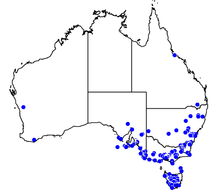
Back نمل نطاط Arabic نمل نطاط ARZ Myrmecia pilosula Catalan Myrmecia pilosula CEB Myrmecia pilosula German Myrmecia pilosula Spanish Myrmecia pilosula French Myrmecia pilosula Dutch میرمېسیا پیلوسولا Pashto/Pushto Myrmecia pilosula Portuguese
| Jack jumper ant | |
|---|---|

| |
| Worker ant | |
| Scientific classification | |
| Domain: | Eukaryota |
| Kingdom: | Animalia |
| Phylum: | Arthropoda |
| Class: | Insecta |
| Order: | Hymenoptera |
| Family: | Formicidae |
| Subfamily: | Myrmeciinae |
| Genus: | Myrmecia |
| Species: | M. pilosula
|
| Binomial name | |
| Myrmecia pilosula F. Smith, 1858
| |

| |
| Occurrences of the jack jumper ant reported to the Atlas of Living Australia as of May 2015 | |
| Synonyms[1][2] | |
| |
The jack jumper ant (Myrmecia pilosula), also known as the jack jumper, jumping jack, hopper ant, or jumper ant, is a species of venomous ant native to Australia. Most frequently found in Tasmania and southeast mainland Australia, it is a member of the genus Myrmecia, subfamily Myrmeciinae, and was formally described and named by British entomologist Frederick Smith in 1858. This species is known for its ability to jump long distances. These ants are large; workers and males are about the same size: 12 to 14 mm (0.47 to 0.55 in) for workers, and 11 to 12 mm (0.43 to 0.47 in) for males. The queen measures roughly 14 to 16 mm (0.55 to 0.63 in) long and is similar in appearance to workers, whereas males are identifiable by their perceptibly smaller mandibles.
Jack jumper ants are primarily active during the day and live in open habitats, nesting in bushland, woodlands, and dry open forests, surrounded by gravel and sandy soil, which can be found in rural areas and are less common in urban areas. They prey on small insects and use their barbless stingers to kill other insects by injecting venom. Other ants and predatory invertebrates prey on the jack jumper ant. The average worker has a life expectancy of over one year. Workers are gamergates, allowing them to reproduce with drones, whether or not a queen is present in the colony. The ant is a part of the Myrmecia pilosula species complex; this ant and other members of the complex are known to have a single pair of chromosomes.
Their sting generally only causes a mild local reaction in humans; however, it is one of the few ant species that can be dangerous to humans, along with other ants in the genus Myrmecia. The ant venom is particularly immunogenic for an insect venom; the venom causes about 90% of Australian ant allergies. In endemic areas, up to 3% of the human population has developed an allergy to the venom and about half of these allergic people can suffer from anaphylactic reactions (increased heart rate, falling blood pressure, and other symptoms), which can lead to death on rare occasions. Between 1980 and 2000, four deaths were due to anaphylaxis from jack jumper stings, all of them in Tasmania. Individuals prone to severe allergic reactions caused by the ant's sting can be treated with allergen immunotherapy (desensitisation).
- ^ Brown, William (1953). "Revisionary notes on the ant genus Myrmecia of Australia" (PDF). Bulletin of the Museum of Comparative Zoology. 111 (6). Cambridge, Massachusetts: 1–35.
- ^ Johnson, Norman F. (19 December 2007). "Myrmecia pilosula Smith". Hymenoptera Name Server version 1.5. Columbus, Ohio, USA: Ohio State University. Archived from the original on 2 April 2015. Retrieved 1 April 2015.
© MMXXIII Rich X Search. We shall prevail. All rights reserved. Rich X Search